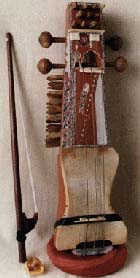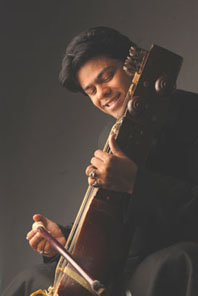 The
sarangi is the most popular bowed instrument of India. Like
the sitar, the sarangi's history is quite old. This instrument
began as a voice accompaniment, but gained a reputation as
a wonderful solo instrument. The sarangi, when played by a
master, is capable of closely imitating the nuances of the
human voice.
The
sarangi is the most popular bowed instrument of India. Like
the sitar, the sarangi's history is quite old. This instrument
began as a voice accompaniment, but gained a reputation as
a wonderful solo instrument. The sarangi, when played by a
master, is capable of closely imitating the nuances of the
human voice.
This instrument is made of a block of tun wood, with a goat skin stretched over the body. There are 3 main playing strings and 30 to 40 sypathetic strings.
The technique used to play the sarangi is to play the main strings with the tops of the fingernails of the left hand. It is bowed with a heavy bow like the ones used for the esraj and dilruba.
History
The
history of evolution of Sarangi is in itself a tale of romantic
hues. Legend has it that once, long long ago, a hakim (a physician), weary and footsore from his travels, lay down
to rest under a tree when his ears were assailed by melodious
notes emanating from the forest denseness. A search revealed
the dried-up hide of a dead monkey stretched over the branches
of a tree. As the gentle winds caressed the hide, melodic
sounds wafted forth. Thus, believe the faithful, was born
- Sarangi. In its other ramifications, the chief role in this
tame is attributed to a disciple of the great Pythagoras,
an Egyptian named Boo Ali Ibn Sina.
Legends
apart, however, no authentic account of the development of
the sarangi is available. By inference, it may be assumed
that it evolved, like most of the other known Indian instruments,
from the Dhanuryantram (bow and arrow) used by primitive
tribes for hunting, as also to signal the advent of the enemy.
Descriptions in Ramayana and the Mahabharat of the reverberating sounds of Rama's bow, Sharang and Arjun's bow, Gandeeva which are said to have
demoralized the enemy camp, lend color to this inference.
It is believed that this particular sound later inspired the
design and shape of the bowed instruments used by primitive
tribes. The curvature of the bow provided the idea of constructing
the body of the instrument and connecting both ends with gut
string. Primitive Man used intestines of wild animals to make
the strings. There are indications that the horse-tail hair
was also used to manufacture the bows. 
From the point of view of shape and structure, the ancient musical instrument without the frets known as Ghosvati or Ghoshak Veena, was perhaps the closest to the later day sarangi. In more modern paralance, the Pinaki Veena, a gut-string bowing instrument described in sarang Deva's Sangeet Ratnakar (13 A.D.) bears close resemblance to the sarangi we know.
We find that practically all over India instruments very akin to the sarangi have been in vogue. Unlike the more polished and perfectly shaped sarangi poularly used today, these instruments known as the ravana hatha in Western India, kingri in Maharashtra and Andhra Pradesh, kunju in Kerela, pen in Manipur, kamayanch in Rajasthan and banam and kenara in Orissa, were made of ordinary wood or coconut shell, devoid of all ornamentation.
The other variations of the same theme are saran in jammu and Kashmir with two steel and two gut strings and nineteen subsidiary strings (Taral) with the resonator being covered with sheep or goat skin; the Sindhi Sarangi, the Jogia Sarangi, the Gujaratan Sarangi and Alabu Sarangi.
The introduction of sarangi into the classical tradition has been slow process though it would seem to have established its credentials as an incomaprable accompanying instrument even in this sphere as early as the days of the great Tansen. As the veena acquired solo status, the range and pitch of the sarangi, the power and sensitivity of its tonal qualities, and its rare capacity for reproducing the gamak, so indispensable to the singing of the khayal, dhrupad and thumri of Hindustani Music, made it a natural successor to veena.
Unfortunately for sarangi, in the very process of it's induction into the classical tradition have lain the seeds of neglect and the threat of oblivion in the future. With the patronage of Hindustani classical music passing into the royal courts, and the emergence of Kothas and havelis as an integral part of the Nawabi way of life, the sarangi became identified with the mehfils and tawaifs (dancing girls). An ample illustration of the travails of the sarangi player is the fact that some of the all time greats of Hindustani music like Ustad Abdul Karim Khan, Ustad Bade Ghulam Ali Khan and Ustad Amir Khan who had begun their artistic careers as sarangi players had to disown their past on their path to fame.
In 16th and 17th century, sarangi-playing bards, singing religious songs and heroic ballads, began flocking to the Indian cities. They were at best tolerated and could in no way compete with the more established beenkars and rababiyas. A decent living could perhaps be made by teaching and accompanying the vocalists.
Playing the Sarangi
The bow is held palm upwards. It is drawn across the main strings, just above the bridge. The fingers of the left hand note the strings. This is done by pressing and sliding the bottom of the fingernail against the side of the string. Players often use talcum powder on their palms to facilitate the gliding of the hand up and down the neck. The gliding of your nails along the strings creates the sound characteristic of Hindustani music.
If you
enjoyed this item, please support it by adding it to Digg, Netscape, Furl, Yahoo or StumbleUpon
*
Inspiration by : infoweb.co.nz




